TIitRoyal Plmtogmphic Society
Theres the special dinner on saturday enning, when all thoughts llight be about the wine & the With the rest of the weekend wellorganised into,lllllly interesting workshops & lectures- teachins and opportunities for that friendly chat with others like ourselves, interested in A. photography B. antiquity and c. the latest advances in both of these fields, not forgetting a chance to take a breather outside of the in nry pleasant surroundings mdisturbcd by the hubub of a.>dem everyday life.
The venue for the weekend being in the new sports built on the site of the old Crystal Palace, now a parkland area housing uny of general interest. The lake areas where authentic stone replicas in full size of prehisto ric ilay be seen 0011111 natural wooded setting, a boating lake and Zoo park are all added intenests to the photographer.
The indeor sports facilities of the Complex are world fuaous, can be ava~lable to conference delegates at DOextra charge, a pleasant alternative to those perhaps wishing a little light relief over a highly organised weekend,so the" it is, its a Confen,orksbooosi1.1111 • is it not?
Such an enterprising weekend by any other than the go-ahead Archaeological aroup of the Royal Photographic Society, would cost each delegate well over £6o.OO and day delegates at least £15.00 a day. However the Archaeological Group would like to see more spirit brought back into tile L1>ndonRegioo, so this . conferworkshopos:inllis subsid,fsed by the Arts Comicil & tho1 GLC. OD the one hand and run by this co.dttee on as DOD-profit basis as is practic6'.Its just got to be the finest value this or any year •
.Ul will be of a hJ gh .:irder, iD particular a Yery special arrangement &aa been for the dinner en Saturday eYening, good wine of course.
Tes but what of the progra=e,whats going on?
--f ',-~: ; m, Ii~
·:
·c·c
-< m z --f Ro z
e Gonfe!"Vorlc:,hoposiumreal.lywill be three separate Tery interesting progrannes. The 111ai11 theae thia being IT year, or I.nfonaatioa 'l!chnulogy Year, will be to inform and take part in the finding out about what bas happened to the old fla~h light, electronic flash to-day is too sophisticated for eTen the &Tera&• electrician to coaprehead, let alone a.a archaeologht (who said that?) or a pictoriali~t,also who would thiak that naah techniques could outdo all other forms of illWlliaation in eTery field, for subtleness for clarity for aood,for tbe photographers lot a deal· easier to bear.Participation with our caeras is desireable to obtain full benefit the lessons to be learned so bring out the old Pul'II& Specials a.ad Ikontas or ••en :he lodak pancakes a.ad join in,you could \/in one of seYeral prizes •• Flash vill be featured on than one occasioa,coYering we hope all iJlterests.(yes that too)so that we will take the opp<>rtunity over the weekend to slot in quite different features as for a very interesdng lecture on early Egypt,with personal reaeuJ.sces(no,not Pharoa) a very full list of al ~mate lectures,show~ will be published with the tickets as well as a list of contributing manufactures. Heabers and others are requested t let the organisers have short (or long) papers to be read during coffee breaks etc,whlch c:in bo expand•~ to utch the length of t:uie likely to be required to cOTer the subject,(Parlcinsons Law ?)when it is hoped audience participation vill uke f r varied & linly discussion ranging duri.ng the veekend onr 11&11:y & nried subjects.
A~d to this,the 2nd exhibition when a!l photographs brought along will be Ji.splayed, as al~o those guests & other showa ,slide presentations,and other delights are to be part of this superb weekend.
A rare opportunityJplaces will baYe to be strictly on a first coae first serYed basis,the number of residental delegates that can be accepted cannot exceed JO,that will bo for the whole weekend conference. for just the Saturday as full residental about 40 places will be aYailable. whilst as day gucHs an additional 50 or 60 places vill be offered.( B .S: be possible outslJe the complex in local hotols,do this if you are unlucky en()ugh not to get f Ute 30 tllocated places that we are liaited to as full residents inside the a.,
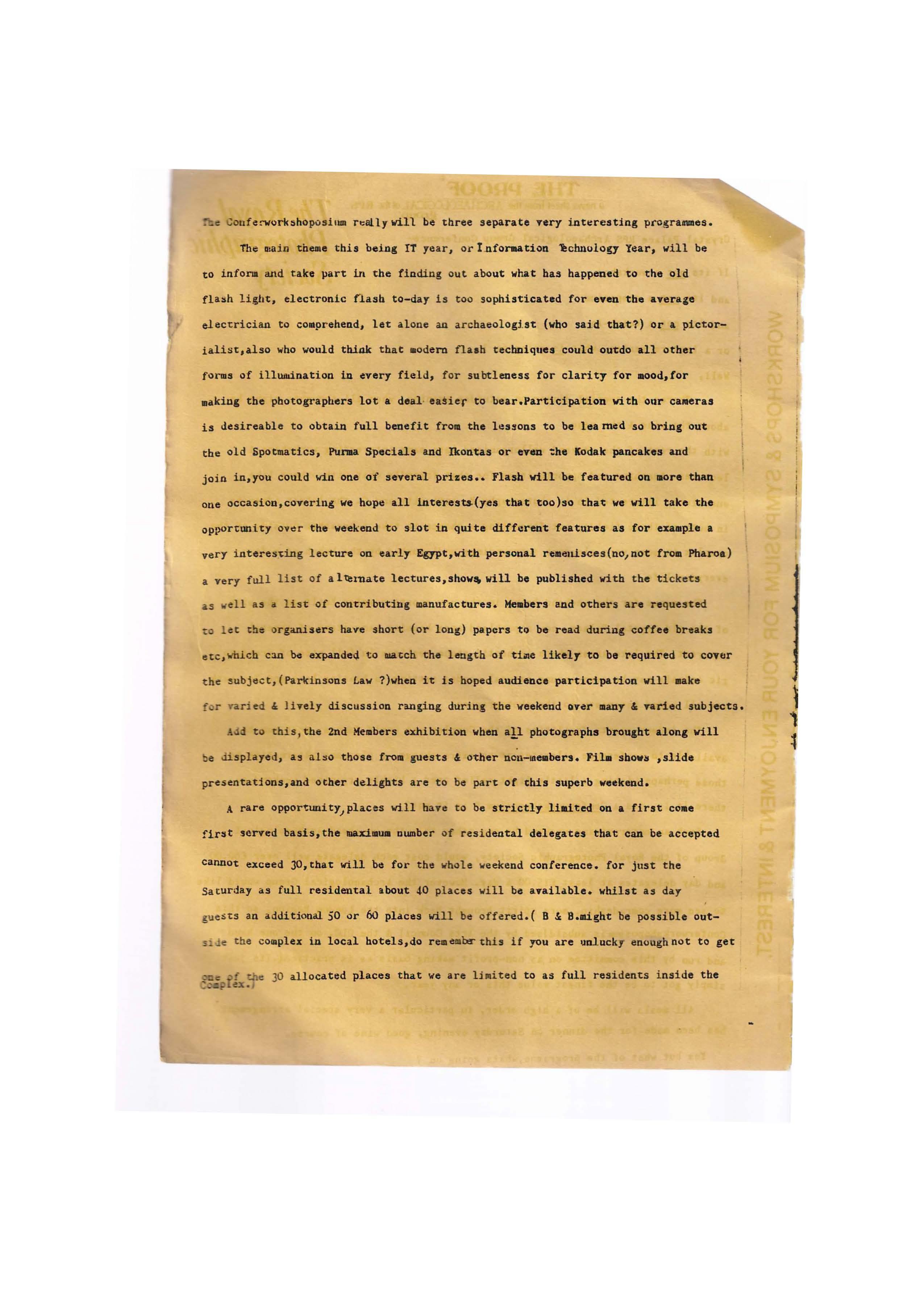
• My Method> ser .ies
 by YOIIT CHAIRMAN
by YOIIT CHAIRMAN
A touch of the Tints.
Wash print. well,(black & white), Bleach in'rerri, rinse in clean water/ hypo bath to stop bleaching. Re-develop or tone.
The re-developing process will not fully recover the total highlight image, resulting in a degree of contrast improvement in the highlights, cleaning up the print in general, where it can do the most good by adding a brilliance often very beneficial to many photographs.
This brilliance, is also to be fom1d when toning the bleached image brown, with a toning bath of Sodium Hydroxide. lmfortunnately not only are the highlights lightened, but generally a re-toned print will be lighter all over, to the-detriment of print quality.
To offset this inevitable reduction of print density, prior to placing the print into the bleach solution, a pre-bath in the toner (Sodm Hydxd) will endow the print with an added density upon later re-development or toning. The time that the print is allowed to soak in the pre-bath of S-Hydxd will to a great extent determine its effectiveness in re-enforcing the final image. Times from a few seconds immersion to minutes vi.11 not only effect the print density and image quality, but will play a bjg part in creating varying image tones from the near sepia obtilied \olith the strrlght into the bleach method to variations of black brown walnut purple,possible with extended pre~bathing in the toner.
Additional black re-enforcement may be obtained by subsequent to bleach bathing the print, immersing in nonnal print developer for a minute or so. Good print rinsing should always accompany these various baths to wash out unwanted chemicals and ensure a print free from odd stains, by using just the bleach toner baths,in any order you wish, and not the standard developer for after treatment,the toning of the image ~uld seem to offer at least some measure of realy lasting permanence for the photographs treated in this way, not that that in itself is the only reason, for toned prints are once again a different form of artistic expression and many pictures can gain considerably frorn tones ir. brown and white, or black, brown & white. So that considering that a print is worth making on normal black & white materials, it is doubly worth con idering in this added dimension.The Archival permanence of the plain brown toned print is another matter and still could be enhanced with tne added lack i age for at least part of its nov long life, where surely the added pleasure derived from such enhanced images will have been well worthwhile 1 ng after the print has reverted to what might ltave been its original brown on] y ma11• •.l.e.

Sepia toners will f c equal archival virtues, but using same in a darkroo "'.i. door in order to protect che re impossible. f :. C
Halving or inc1easing fi jevelo en I ouse us~ as· ~ll,with ost impossible, e ust close the darkroom :;:akes 1 s use also next to con1:•• e in rder to adjust film contrast to suite pr.per grades, eg; incre~sing e~eloped Gammain order to print a negative that would otherwise print no ally on a grade 3 papP.r, to instead print onto a grade 2 paper is the usual indeed the only straighforward remP.dy available to the photographer.
Like many other corrective proceedures, the method may be correct, but the results may be far from perfect or indeed satisfactory,unless the negative being processed is going to be capable of yielding a satisfactory print in the first place.
Switching grades of printing paper will not endow the negative with qualitities that it does not have, due possibly on the one hand to insufficient exposure, or gross overexposure, or on the other hand to a development process inadequate due to wrong chemical make-up, (which could be due to one gross of several unrelated causes.) , or tmder-development or over-development. The tent Gross over-development is deliberately chosen, because any Gross over-exposure or over development will distort the negatives tonal values beyond satisfactory retrieval. Moderate degrees of over e;,rposeure or development do not present quite· the same problem, in the case of moderate overexposure errors,highlights will be effected least, in proportion to the shadow detail, resulting in only a meagre density increase in the Highlights, and extend the recorded shadow detail into what would otherwise be clear film area in all probability, increasing the recorded detail beyond the capability of the p1·inting i;aper.
Making prints (enlargements) from negatives having far greater tonal range than the paper is capable of re-producing is not a fault likely to be readily noticed by the average amateur printer,in consequence, neither is the fault that a negative is abundant in recorded tones more at one end of the tonal range than the other,eg; masses of detail either in the highlights or the shadows which will never be seen in a print unless deliberate exposure tests are made perntitting these extended tonal values to be defined almost one tonal range at a timo, usually, providing a print can be ~ade yielding some record of the origu1al scene,the amateur novice printer believes that a satisfactory print oft.he negative has been made.Only in the rarest of scenes where brilliant highlights and realy--de~p black shadows exist does it prove realy difficult to recoru the entire scene on negative material, only then is there any excuse for failing to print the FULL tonal range onto the printing paper,for the sole reason that the ~eflectance of printing paper can never be the equal of all the ~ones that may be recorded ln the negative,(suitably precessed} end
(ONTRIBU
TOR Two diHerent approaches;
BY T.GREY.

The two prints illustrating this article show two very different a?proaches to portraying the best features of a subject.
The little Saxon pillars in :J,uidenham church in Norfolk, thought to have once supported a font, project only an inch or two from the wa.li.l, and their tone is little different from the wall itself. They sta11d in a dark corner, where there is rather too little light for photography, aP.d what there is i3 too flat to show the form of these pillars.
This is a good subject for the use of a small flash well off to one side of the camera to give relief to the pillars. At the time I used a PF5 flashbulb, but today I'd use a small electronic flashgun on a long lead. The contrast boost of a hard single light on an inherently soft subject has :rielded a nice sparkling print.
The chevaux de frise at the entrance to ihe hillfort at Cademuir near Peebles is a very different subject. It looks quite dramatic to the eye, ~ut fer most of the year can't be photographed because the tall grass hi.es he 3 ones. I chose a d.ay in December when the grass hac/1ied back, was bleached ne~..rl •,1hi e, and had a covering of hoar frost. A strong low su.~ almost into •ne ca:r.era lens threw the stones into sharp relief. The use of a 55m e~s n he 2i sq. HaJDiyaflex gave the stones prominence in the foregro,md, ;,hils i;;ivi:lg a nice hint of the lMdscape of the ilanor Valley in the backgro md. e ,ix sure was 1/15 sec. at f/12 with 2x yellow filter on Tri-x evelope1 in :jcrodol-x. In printing, the landscape top part of the print needs consiaerable ~x ra exposure, especially at the top left hand corner, "'her~ the sun almost appeare·i i~ the picture. The range of exposure was 10 to 50 seconds.
END

6
John Adams ON- BIG CAMERA WORKSOP
After a period of relative inactiv·ty ile the Gr up recovered from a financial C crisis, which culminated in the de ise of the muchadmired "Archaelog~, we have enjoyed an enterprising series of lectures and workshops. The latest of these, arranged by our enthusiastic new Chai_rman,Victor Hepplethwaite, was held on 1st May at the premises of HowsonAlgraphy Ltd. in Orpington. We·are indeblted to the Directors, particularly Mr. Shaw, for the use of their premises; nineteen members were present.
µV The morning session was devoted to a lecture by Peter Oorricott of HowsonAlgraphy on methods of making lithographic printing plates from line illustrations and photographs. He introduced this with a sketch history of the commercial production of lithographic plates in the U.K., culminating in the amal\ga_mationabout ten years ago, of HowsonLtd and Algr~phy Ltd., as part of the Vickers Group, to form the largest producers of lithographic plates in Europe. Turning to the technical problems involved in using these plates, the first of these is the extreme photographic insensitivity of the emulsions used. These emulsions are usually dichromated col}oids, which can be processed to give a relief image capable of accepting printing ink in the areas corresponding to dark areas of the original image. Arc lamps were originally the only sources available of sufficient intensity. but their inconvenience in use led to their replacement, first with pulsed Xenon lamps and then with mercury halide lamps.
t'fr Process cameras are large by normal photographic standards, often consisting of a dark room to house the plateholder and a'gallery', where the copy holder mounted on rails, may be 6 metres from the plate holder; the lens is set in the intervening wall and all movements are controlled- by servomotors from the darkroom. Lenses are apochromatically corrected and geometric errors are usually li~ited to 0.2mmper metre. To meet these requirements, the angle of view is only 40-45° and the maximumaperture on f/8 or f/9; this is used fer focussing, working apertures being normally f/16 or f/22. For less critical work, vertical cameras are now coming into use; these employ 'wide-angle' lenses and are often computer controlled. Originally, of course, glass plates were used, sometimes nearly 2m square; now films are employed, supported on a vacuumeasel to maintain _;:;;, flatness.
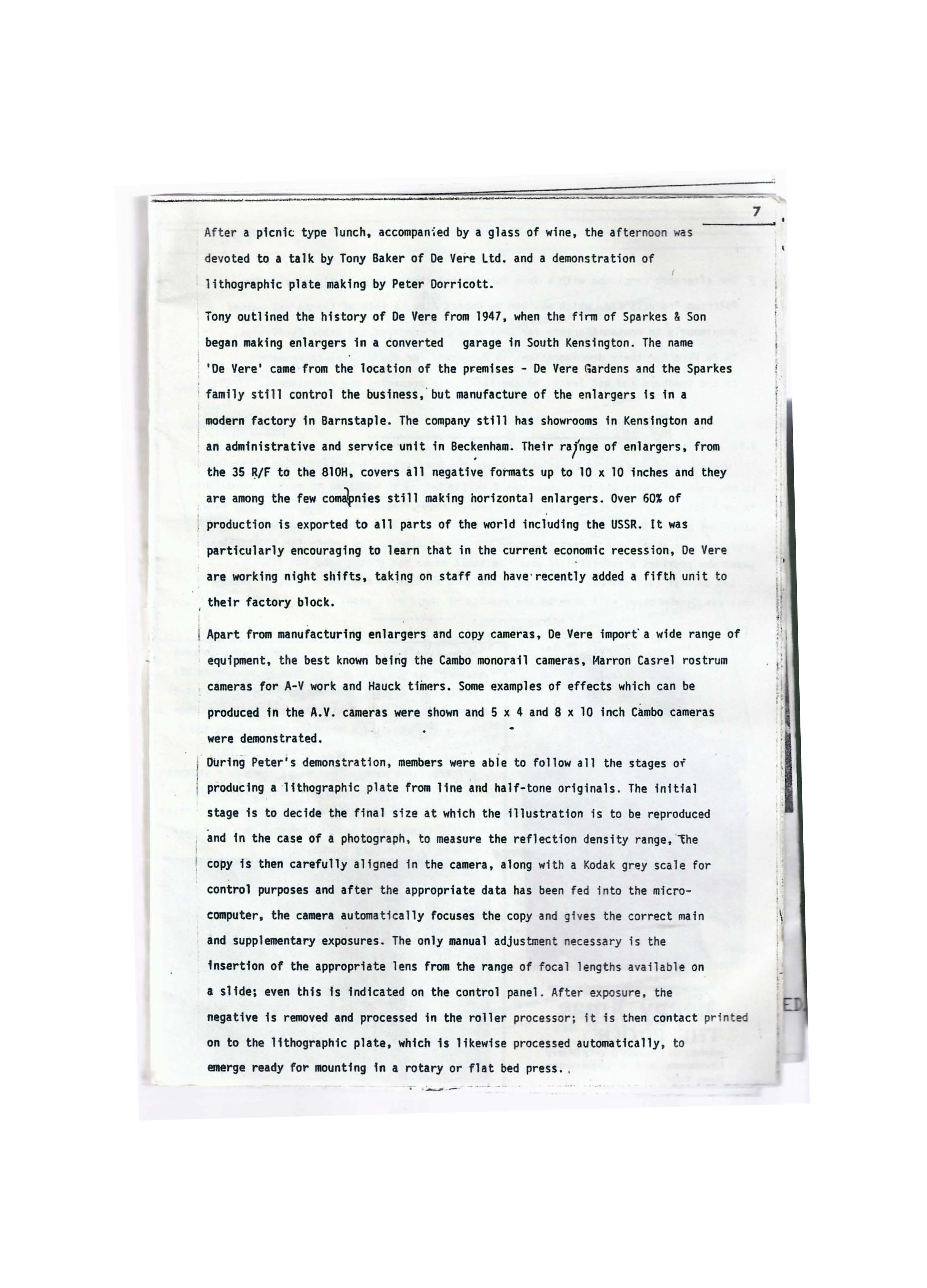
After a picnic type lunch, accompan;ed by a glass of wine, the afternoon was devoted to a talk by Tony Baker of De Vere Ltd. and a demonstration of lithographic plate making by Peter Dorricott.
Tony outlined the history of De Vere from 1947, when the finn of Sparkes & Son began making enlargers in a converted garage in South Kensington. The name 'De Vere' came from the location of the p~emises - De Vere Gardens and the Sparkes 'family still control the business,· but manufacture of the enlargers is in a modern factory in Barnstaple. The companystill has showroomsin Kensington and · an administrative and service unit in Beckenham.Their rafnge of enlargers, from the 35 ~/F to the BlOH, covers all negative formats up to 10 x 10 inches and they are amongthe few co~nies still making horizontal enlargers. Over 60%of production is exported to all parts of the world including the USSR.It was particularly encouraging to learn that in the current economic recession, De Vere are working night shifts, takjng on staff and have·recently added a fifth unit to , their factory block.
j Apart from manufacturing enlargers and copy cameras, De Vere import·a wide range of equipment, the best knownbeirig the Cambomonorail cameras, Marron Casrel rostrum _ cameras for A-Vwork and Hauck timers. Someexamples of effects which can be produced in the A.V. cameras were shownand 5 x 4 and 8 x 10 inch C~mbocameras were demonstrated.
During Peter's demonstration, memberswere able to follow all the stages of producing a lithographic plate from line and half-tone originals. The initial stage is to decide the final size at which the illustration is to be reproduced and in the case of a photograph, to measure the reflection density range, the copy is then carefully aligned in the camera, along with a Kodakgrey scale for control purposes and after the appropriate data has been fed into the microcomputer, the cameraautomatically focuses the copy and gives the correct main and supplementary exposures. The only manual adjustment necessary is the fnsertfon of the appropriate lens from the range of focal lengths available on a slide; even this fs indicated on the control panel. After exposure, the negative is removedand processed in the roller processor; it is then contact printed on to the lithographic plate, which is likewise processed automatically, to emerge ready for 110untingin a rotary or flat bed press
7 'I
~-R The afternoon concluded with ad a Paterson Products Ltd. which was he eter kindly donated by JJ, oert Pfu. A vote of thanks was passed unanimously to HowsonAlgraphy for pro ·o· g the premises and other facilities, to De Vere for their demonstration, to atersons for the digital thermometer, to the speakers and not least, to the ladies for preparing the refreshments.
John Adams. N,B,
Members were advised to bring along their own sandviches, beverages being •Free issue" in the ennt not only did we arrange tea & coffee but as an addition to 111emberssandwi.che~ •Wine" Cold chicken legs and crisps were passed ro1D1d, followed by sponge cake and an excellent quiche,Iour Chairman & Vice Chairman do try to look after members on these occasions, we should not forget to extend our thanks also to the agents for ARGENT&brolllile paper who provided a selection of paper in small sizes and photographs for display, Let us hope that meiabers who did have the good fortune to acquire a •sample" packet of this new German paper will show us the results of their work soon, ed. HappyXmas THE
wishes its readers a very Merry Christmas and a prosperous New Veer.
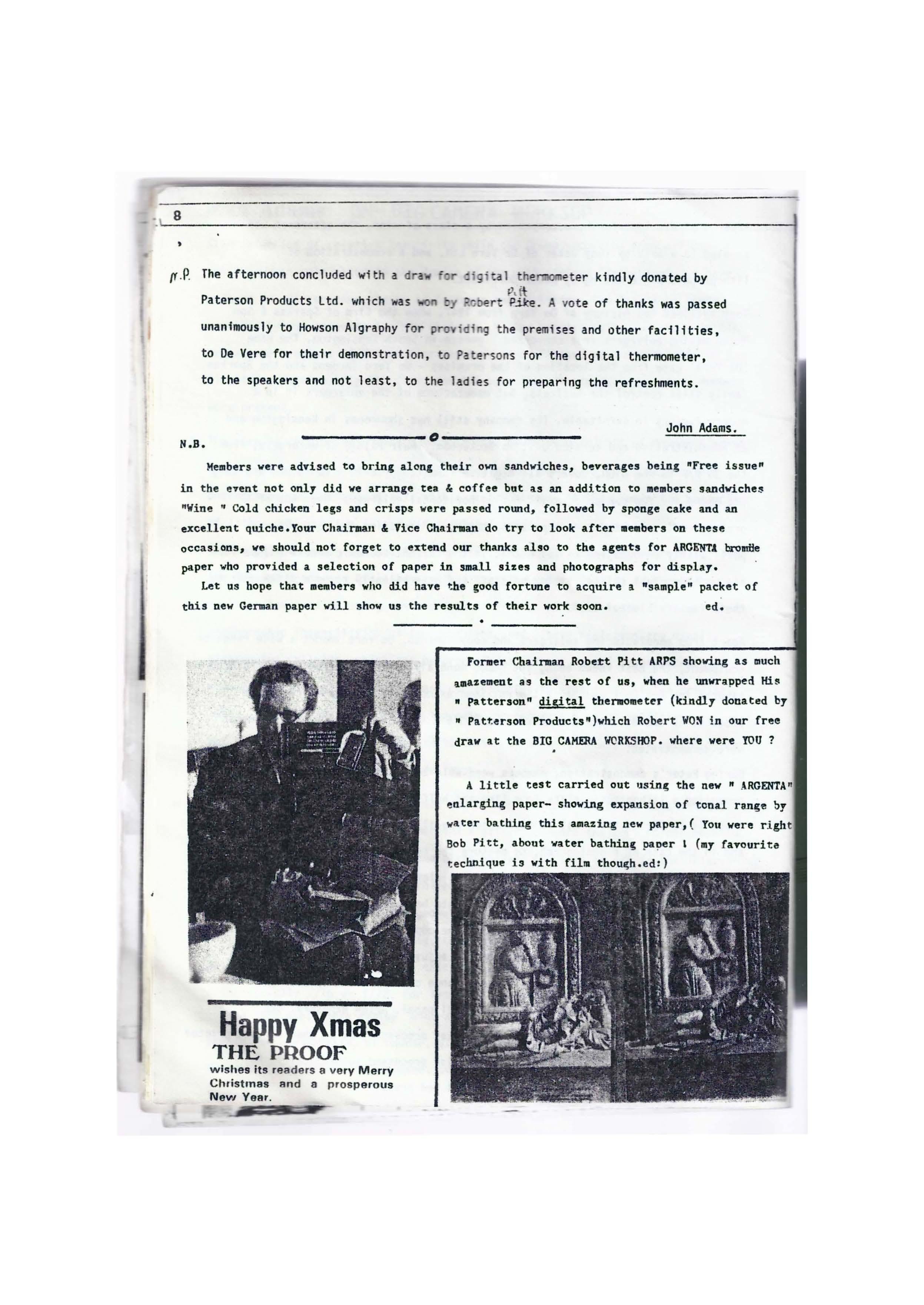
Fonier Chaizinan Robett Pitt ARPSshowing as much amazement as the rest of us, when he unwrapped Hi~
• Patterson• digital tbenaometer (kindly donated by
• Pat~erson Products•)which Robert WO~in our free draw at the BIG CAK!lU WCRKSmP.where were YOU?
A little test carried out using the new• ARCENTA• enlarging paper- showing expansion of tonal range by water bathing this amaziog new paper, ( You were right Bob Pitt, about water bathing paper I (my favourita techn.ique is with film thou~h,ed:)
8
--------0---------
PROOF
i
SHROPSHIRE COUNTY COUNCIL
R. c. S.wten County Secretary
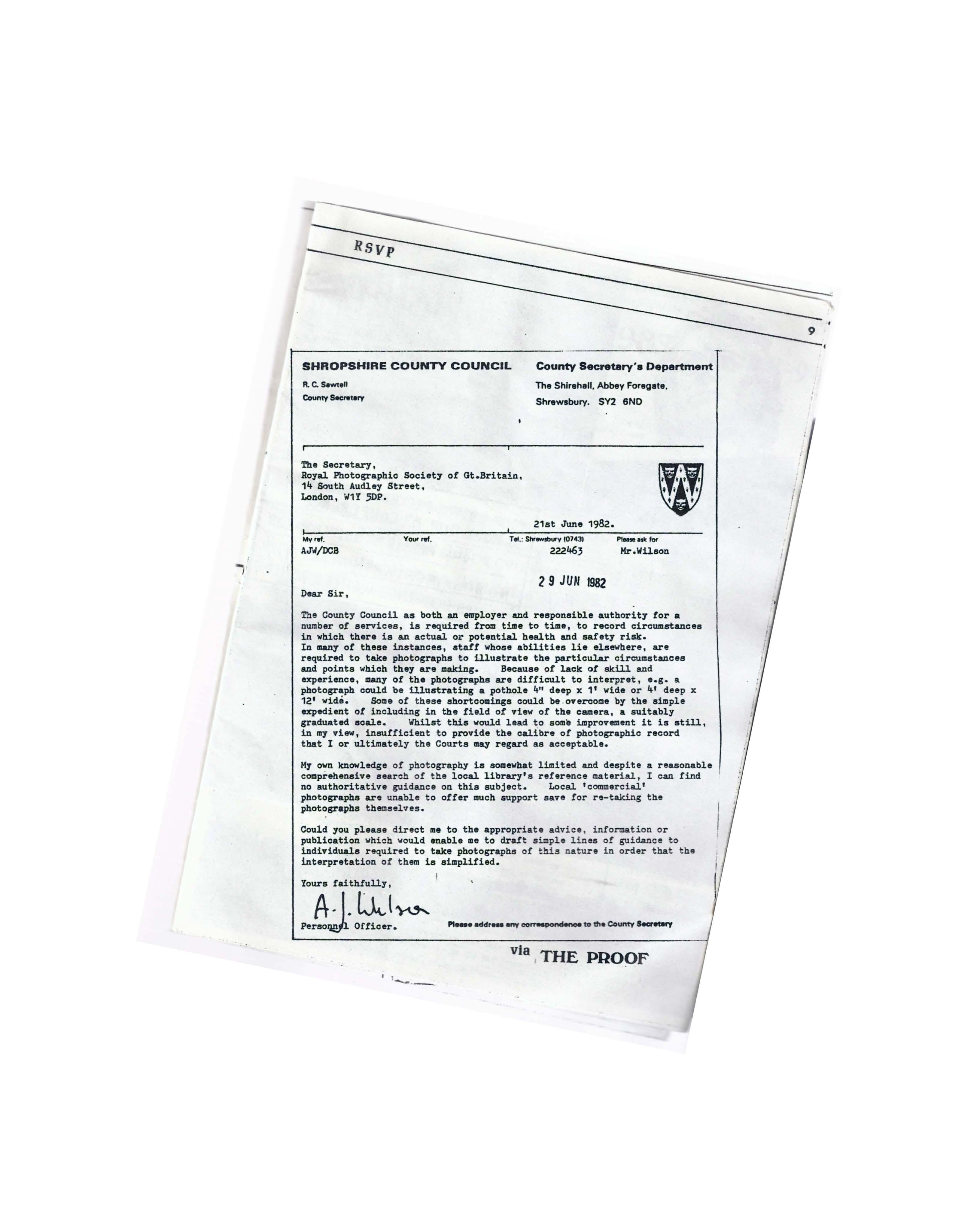
County Secretary·• Department
The Shirehell. Abbey Foregate. Shrewsbury. SY2 8ND
The Secretary, Royal Photographic Society ot Qt.Britain, 14 South Audley Street, London, il1Y 5DP.
21st June 1982. Myrof, AJw/DCB Yourrof. TII.: Shr-..,,,!07•31 222463
2 9 JUN 1982
Dear Sir,
The County Council as both an employer and responsible authorit;r tor a number ot services, is required tram time to time, to record circumstances in which there is an actual or potential health and safety rin. In man;r ot these instances, stall whose abilities lie elsewhere, are required to take photographs to illustrate the particul.ar circumstances and points whioh they are making. Because ot lack ot skill and experience, man;r of the photographs are di!!icult to interpret, e.g. a photograph could be illustrating a pothole '+" deep x 1 1 wide or 4 1 deep x 12 1 wide. Some ot these shortcomings could be.overcome by the simple expedient ot including in the field ot view o! the camera, a suitably graduated scale. Whilst this would lead to some improvement it is still, in my view, inau!!icient to provide the calibre o! photographic record that I or ultimately the Courts may regard as acceptable.
Ky own knowledge o! photography is somewhat limited and despite a reasonable comprehensive search o! the local library's re!arence material, I can !ind no authoritative guidance on this subject. Local •commercial' photographs are unable to otter much support save !or re-taking the photographs themselves.
Could you please direct me to the appropriate advice, information or publication which would enable me to dratt simple lines of guidance to individuals required to take photographs of this nature in order that the interpretation or them is simplitied.
Yours !aith!ully, I
vta , THE PROPF ·---·--
..tJ.~~-~
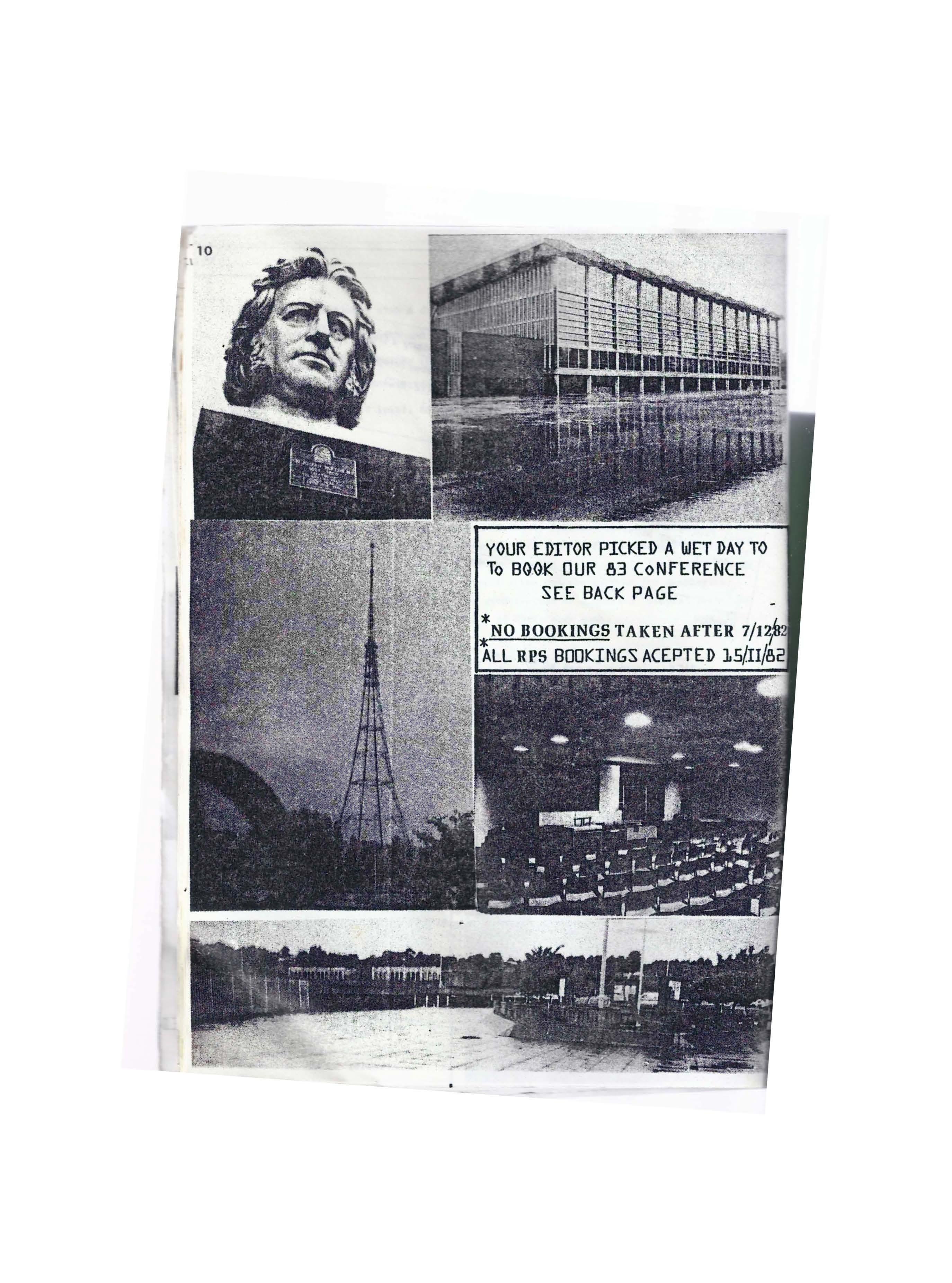
YOUREDITORPICKEDA WETDAYTO To 80.0.KOUR 83 CoNfERENCE SEE BACK PAGE
1 *NO BOOKINGS TAKEN AFTER 7/12fo
ALL RPS BOOKINGSACEPTED15/II/82
10
:/
; ·<'.· ~r.;.; ;;,;::::~.
-----IMPORTANT ANNOUNCEMENT-----
Preservingail anliquitythroughbetter photographynow. 11
CRYSTAL PALACE 1983 Jan 7-8--9
RPSCONFERENCE
RESIDENTS· TEA TIME FridlW to TEA TIME Sund~v.aJl inclusive£28·50 _ · Non residents- Sat.inc guest night Special Dinner· l £ 8·50 Sunday £4·50
Non Group members add 15'X,Non R PS members add 50'.t
: This conference is heavily subsidised by the Sports Council. VAT <at15U to all totals please
Cheques made out to the Royal Photographic SocietyArchaeologyGroup 0 All cheques &booking forms and enquiries please to Chairma~ 66&:.'I , No.12Marlings Park Avenue. Chislehurst.Kent. BR7 6QW; Orpington 2332!;(66) tel:
PLACES -WILLBE RESERVEDFOR GROUP MEMBERS UP TO END NOV82, Then allocation on Hrst come first served basis I
·meetings
23 Oct 8 2 AIIATKEBT~ 6.45 for 7pa to•h••
Joint aeeting v.lth the Colour Group & 1be Stereoscopic Society,an any net1a4 at the NIil KARYIIARl>C!NTlU!: still on-.----.>~ 1st noor conference rooa, 42 Queen Sqaare.v.c.2. lfeareat tmderp-ound.lfolborn / Chancery t.anr and Russell Sq. Sn:111!0slides of the Creat Exhibitioa 1851 1Jth SATllRDAY. ?.JO for 10 4•30pa. llecttouic nash wrkshov. under the dlr,ec:t:l.on ~f ltllHrs Strobe !'.q_aipment tbdted London.S11:SUD!:CLUB. &ooldn&s will...w_ be accepted after October 9th •••• Telephone Croup Chain,an on Orpington 2-3325 for full details and bookincs.
tltfl S~TURDAY Club,Backg&Jn110aRm. Special Christ11ar Procrame startin1 5.30 pa. c-encinc illustrated lecture by ?.Herbert JONES on r.cn,t-• Fro11 Pharo:\ to Farou.lo:•· 2 l x2¼inch :oonochro,ie glaas slides• (approx 90ailis) Followed by Group •ine & Cheese party wishing to stay all ni&ht should contact the Secret&ry at the S~saae Club.

cancelled due to closure of SESAME l CLUB I
For furdler details or all e..-ects telephone Group on Orpington 2332}.please note this number it ilas been reported incorrectly in the MA?Journ•l.----- 66 23325 · fictor.J .Jleppelthvai!:• 1RPS. Groap ChaiMUll, ' ,______
..c..----ok
Dear Sir,

Monsieur APTED
Department of the Environment Fortress House, 23 Sa.vile Row ' ' LO~DON WlX 2A ____
We have received your letter of 2 April 1960 and thank you nry 111.lCh for it.
We arenry happy at the thought that the Archeodro• of Beaune 1a regarded as of soM interest to your Ministry and to the British public,
You will find attached•~
A folder on the Archeodro• bringing together the inforution you will need for the preparation of your article.
A general view of the interior of the ArcheodroM
A general view of the exterior.
We hope that these docuaents will suffice for the preparation of your article, but in an, case will gladly supply anything else you need for your project.
With best Wishes,
Encl. folder and two phot~phs.
Jacques VaJ.entin

143,loeulftardleW,,,re-750!5 parls
Conception Reallsatlon Chateau [Folder]
HISTOOYOF AN ARCHEODRCME
The projact proposed by our team was to present alongside a motorway a thousand years of the history of Burgundy, fro11 remote pre-history to the Gallo-Roman period • The aim - to reveal to travellers that Burgum.y poeseeees archaeological treasures beyond price.... The future visitor - a motorist preoccupied with his affairs, travelling at speed to distant places.
But how to halt hi11?
A co11110nor garden museua would be useless. Rather an information centre about the archaeology of Burgumy, teapting the motorist to stray f'ro11 the to visit the local sites and aruseUIIIB, For the traveller archaeology on its own was insufficient. There had to be something spectacular. Full-sized reconstruction!< seeined to be what was wanted. But what?
A Gallo-RollllLll such as thoee identified as crop-marks on air photographs tracing out their ground plane?
The Ro-n fortifications at Ales·ia co•plete with ditches as well as and towers of wood?
Who does not re'ca11 his history books?
Our first site works surprised us completely by their scale - the !llllgnitude of reconstruction •••• but machinery short work of ditches and ramparts! A Neolithic hut with i ta thatched roof carried us back 6000 years into the past • • • • • in fact redved our Callie ancestors to live alongside our modern visitors ••••. We had not doubt that there were othe'.!' things besides Asterix,*
Archaeologists helped us with our research, The soul of the exhi'!>ition building was to be a sacred Gallic spring.'fhe scheme was adopted by the Directorate of the Society des Autoroutes Paris -Rhin-Rhone, but also by the Scientific brought together for the purpose.None the less it was iaportant to our future visitor, the 11otorist.
Our re-ined for a long t11118in a state of uncertainty about what to do, then set to work, Certain principles were established,~
A central building would bring together all the information. This would have to be straightforward, simple and understandable ey all. The and sites of,eurgundy would co11ple111entthe information given in the building,
The building would be star-ehaJ>!'d, on plan, a sort of gia.nt 1 ,ori11nta1li1on table opening out onto past.
The reconstructions would be viewed within the buildir.g, completely rebuilt as they once were, There would be two cl=uits round the buildings separated by screens of vegetation, a winter circuit and a sUJ11J11erone.
':'1ere would be ·a Gallic dwelling, a spring, a burial ound and other <l' .,; ele1111nes such aa a Roman road and a potter's workshop1 a Ga.llo-Rosnan villa would co•plete the ense11ble,
Two years of research, six 1110nths of work with contractors initia.11:( disinterested in the project but subsequently involved in 'the 1
13

ARCHA[DROME
a°boye all the help of talented craf SIIO!nwho put at the service of the project thelr skill and knowledge of natural erials. Last but not least tbe archaeologists, arriving diccreetly a t e site, then surprised, astonished and delighted, applying their knowledge o his or t.hllt detall and forming a team with the architects, This WllS the cooperation which gave birth to the Archaeodrome •
Photography 11as for us a useful working tool. Phot,,graphs of sites during the course of excavation enabled 118 to uroerstand 110re clearly the sub-etructure of a building, Air photography lllllde possible rapid comparison between the different plans of Gallo-RoM.n te11ples in Burgundy in the 2nd century A.D.
The Danubian hut 11as reconstructed on the basis of the pattern of post-holes revealed on the surface during quarrying, These traces, now deetroyed, enabled us to deterllline not only the plan of the hut but also to compute froiw their dia.111eter the height of the poles. All the suie apart fro• the basic idea of the Gallo-Ro11&n villa it was air photogral)hs which best enabled us to understand the disposition of the buildings of a villa in Burgundy. ·t
The diffieult proble• to resolve was how to represent the siege of Alesia. In rl!al life the Gallic 'oppld11111 is surrounded by hills and valleys. The area ef': th91.battlefield as a 11holfl covered a rectangle 111easuring soM .5 liy ? kl1011eters. An air photograph flatt1tned the relief so so- other 1118anshad to be found to present Caesar's assault. As an alternative a photographer travelled round the hills enclosing the site taking a series of,Jpanoramic views, The results were unsatisfactory. We then decided to ask an artist to reconstruct the sieg,t on the basis of the panora111ic photographs. The results were excellent. Defence works, sielJfl works 1nd Roa,an soldiers were then added to the painted version of the site photographs'.
•Asterlx is t.he well-ltnONn cartoon character, a Gaul opposing the Ro111&n invaders,

I • ) ar,,r.
OUT
ARCHAEOD~OME.
15
RECONSTRUCTION
CoNTINU
1
AIRIALVIEW LOOKING
4
3
ARTISTS
ToBE

.\
/\venue hislehurst, Kent IW? (.QW
M, H,,,,,......11. I.___

I.1usl a short note to congra(ulatt' yooJ on your 1; splen<li<l first issue of a 11ew Gro11p Newssheet. / l
I thir,k it strike,; pr!>dSPly the right note and : : mix oI news, views ancl photogr:.iphs, and I look forward/ i
•• '"'"" bm., •Ith '°"';""•bi,aoU,c;p;,lloo,. I
./ (Qr MeanGwrl 0,iule 1 > f would be grateful ror ,.One ticket l : your Workshop 'The bigger Camera' on May 1st, and enclose an s.a.e. tor the return o( 1 the ticket in due course. i
Very sincerely I i
01111 er , o ert Pitt , Geoffrey QuickFllPS,(& your editor) enjoying a late ni!ht snack in Fortn1D11& Masons after the lecture giTen by Geoff; at the Sesaae Club,London.
A golden opportunity I_.
Following a conversation with a Site Director who needs some artefacts
Photographed, it may be possible to organize a practical session. This probably would be in London at a time convenient to all concerned.
The most important items are some facetted timber.
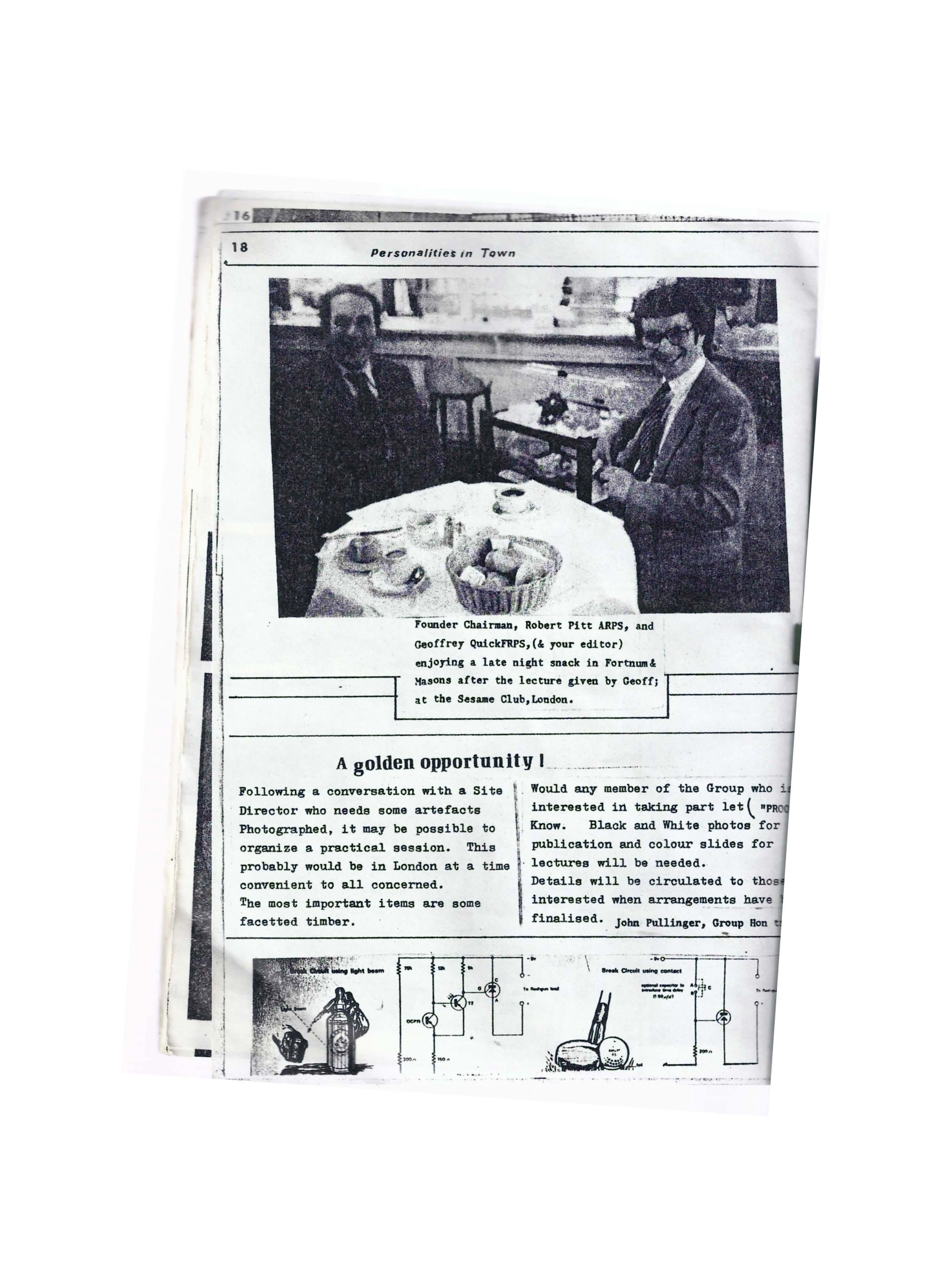
tt.Would any member of the Group who i interested in taking part let\ •PR \- Know. Black and White photos for publication and colour slides for lectures will be needed. Details will be circulated to thos interested when arrangem~nts ha~e finalised._ John Pullinger, Group Ron
18
in Town
Personalities
_______________ _

letters
Suggested stibjsots for Grouo :.Ieetin~
1. Simyle A?paratus for Arc~eological ~nd Arc~it~ct~r~l ','/or!t.
2. The speaker ·Nill demonst1:3.te the uses r,f the follJ\Yin&;:
Sanderson 5 x 4 {~de in 1902)
Zeisl' "Nixe" {all metal camera for Infr~ Red) 9 x 12 cm {roll film and plate back, also roll film adapters)
Zeidd :iaximar 6 x 9 cm~ cut film holders.
Rolleikin back on Rolleicord.
Voigtlander "SUperB" 6 x 9 roll film.
Tripods; filters., etc.
{assisted by Lucie~. J?Des., FRPS)
The Technique of Developing liega.tives in a Dish :J.nd Printing Exhibition Prints and 3¼".:wnochromc lantern slides for exhibition ~nd lecture purposes
n good offer from Herbert J5r.ucyJONE'S FRPS'S.
ad or reply '
spar.e reserved for YOUR article
19

Henry ~aunt of Oxford: 19th century 11.r.otograph:er and an·~iquarien. ,s-------------------------------l
ey Harold hytun.
Early photo~ra!)hs of archaeological and arch;htectural si tas can provide a great deal of infonnation no longer ~vailable above, or even below the ground. Rarely, howev~r, CM much be said ;,.bout who took the :i:,hotographs, or ,-,hen or why. ilny for which we do lmYe gxtra infon::?.tion are of special v?.lue. The Oxfordshire LibrarJ possesses part of the collection of prints by Henry Taunt who r.ad a ~hotographic business in Oxford from 1868 until 1922. This in itself is not particularly exciting, but 1 t so happe::is that we -ll'e aole to find out quite a lot about ~he man beca~se of his r,ublished writings and surviving perscnal documents.
As a professional photographer, income came mainly from 9ortrait work. However, Taunt's great love, end his special ability, was in the·;:eealm of landscape !)hotography. Such scenes frequentl included buildings and sites of archa~ological interest, but he acquired a more definite link with antiquarian studies when, in· 1870, ~e was appointed offi?ial photographer to the Oxford Architectural and F.istoriccl Soci~ty, and so renained until at least 1900. He proudly advertised tr.is position on his publicity literature and was ?.l:iost certainly coilll!lissioned to take photographs on behalf of the society itself .:;,nd also indiYidual meobers. The society still nou:::-ishes, producing the journal Oxoniensia, but unfcrtunately no records survive of photographs being rec,.uested. Nevgrtheless, some ?f those in the Cxfordshi:::'e LibrcrJ collectio1~ must ha,,e been ta.ken with at least a view to the interests and det1ands of the society =d its '"l': me~bers. To illust:::'~te this, the photographs of Dorchester-on-~har.ies can be cited.
This attractiire village contains two archaeological sites :Jf the greatest i::i::ortence; the iron a~e eart111·1orks at Dyke Hills, .::nd -!:he E'.bbey of St.Peter and St.Paul of saxon and medieiral_date on the c•ntsite of 'the J.onan to•.-m. Both were photographed by Taunt.
1-
- ,a.,

by M tum
Toree different.vie•:rs survive of !rJke Eills. The site is a late i=on age oppidum located in the bend of the Thames. The l3lld-,,ard sides are delimited by two massive banks with 3. ditch be·tween them. :Farts of these banks were demolished, despite considerable local a.'ld national opposition, in the 1870's. The first phctograph, circa 1372, indeed shows such d8lllage, with a ma11a:,anding by a partl::,r removed rampart. It is likely that the Oxford .Architectural and Historical , Society sent ~aunt out t~ proviie evidence of the dam~ge, and to record it f6r yosterity. The second picture, ciroa 187;, reveals the ~ubstantiel, but in places broken down double earthwork. Scale and human interest are this time provided by a small boy in the . ! middle distance. The third picture.of about 1890 was taken from an \ elevated position and showed how the earthwork was divided up by fences and used as a stock compound. The earthwork looks as it does today, and the banks visible in the far distance of the first I l photograph have now gone. Earthwo_:::·ks, even of this size, are never ; easy to record, but Taunt successfully captured the scale end I , , , 'texture' of the ramparts.
The photographs of the abbey are more traditional antir,u:::rian fare, and an:rway almost identical pictures could stil~ be taken today. N~vertheless, they are of very hig~ nuality. In circa 1885 Taunt took a detail of the blocked Morman door on the 1·rest end of the north aisle, and around 1890 took a series of external and internal views. They !nclude:1. yhotographs of individual and architectural details such as re-used Rol!lan tiles re•realed beneath :plaster in -';he 1·1all o:;iposi te the south door. 3'J clever tts<: cf lig!:ting Taunt ~anagedcto r.ighlight details of an intricately c?.rved effig-J (posaibly of Sir John Holcombe) and ski1T1Uly r'?corded the figures of, the ~postle3 on ~he 12th century lead font.
Henry Taunt ·;;as not merely a photographer, but also developed a '-- publishing business which producec. a sertes of guides which he wrote himself. One of these was· entitled Dorchester (Oxon) and its Abbe''• In this he sensibly ~iecusses the ~rke Hills earthworks, ref~rring to ".!eltic coins found within the site, and correctly assigned it to the British. Likewise, he located the Roman town tmder the pr~sf:mt village on the basis of finds of coins, pottery and inscriptions. The abbey is adequately described, and illustrated with his own photog~aphs. Although not a work of great originality, it shows Taunt cclnverse.nt with contmporary antiquarian and archaeological thought and method.
Another way in which Taunt revealed his antiquarian interests was by his membership of the Ancient Order of Druids. He was prominent in the ilbion Lodge at Oxford, and was for a time Noble ,u-:)h-Druid. ·Although this interest might today indicate a non-academi:) interest, a look at Taunt's book The Rol1right Stones: the St~nehen.ge of Oxfordshire shows that he applied the same critical thought and judgement to megaliths as to the :ess romantic and emotive earthworks and churches. 'l'he various stones are described and illustrated with plans, old engravings and his o~m photogr2.phs. The folklore of Rollright had a whole chapter bu~ he considered these stories merely as "quaint ideas which have grown up around it in many, ma.-iy years". ~espite a fin2l section on the modern Druids, the book ceteals suggests that Henry Taunt can ~e considered a fair antiquar- 3 of his da.~r, which only enhances the great and ·1:1st1.ng archaeological ,,3J.ue o.t' his :,,hotogrephs.
?\-10 'books have 'been published on Hen17 Taunt md hills photog-:-aphs, al though n::>ne of those mentioned are illustrated. The En.v.lancl of F.enry Taunt, Victorian Photogre:oher. ed. BrJ~ll Bro\'m. Roulled~e Kegan Faul. 1973.
Henry T~unt of Oxford, A Victorian Photogranher, O:dord Illustrated ~ess. 1973.
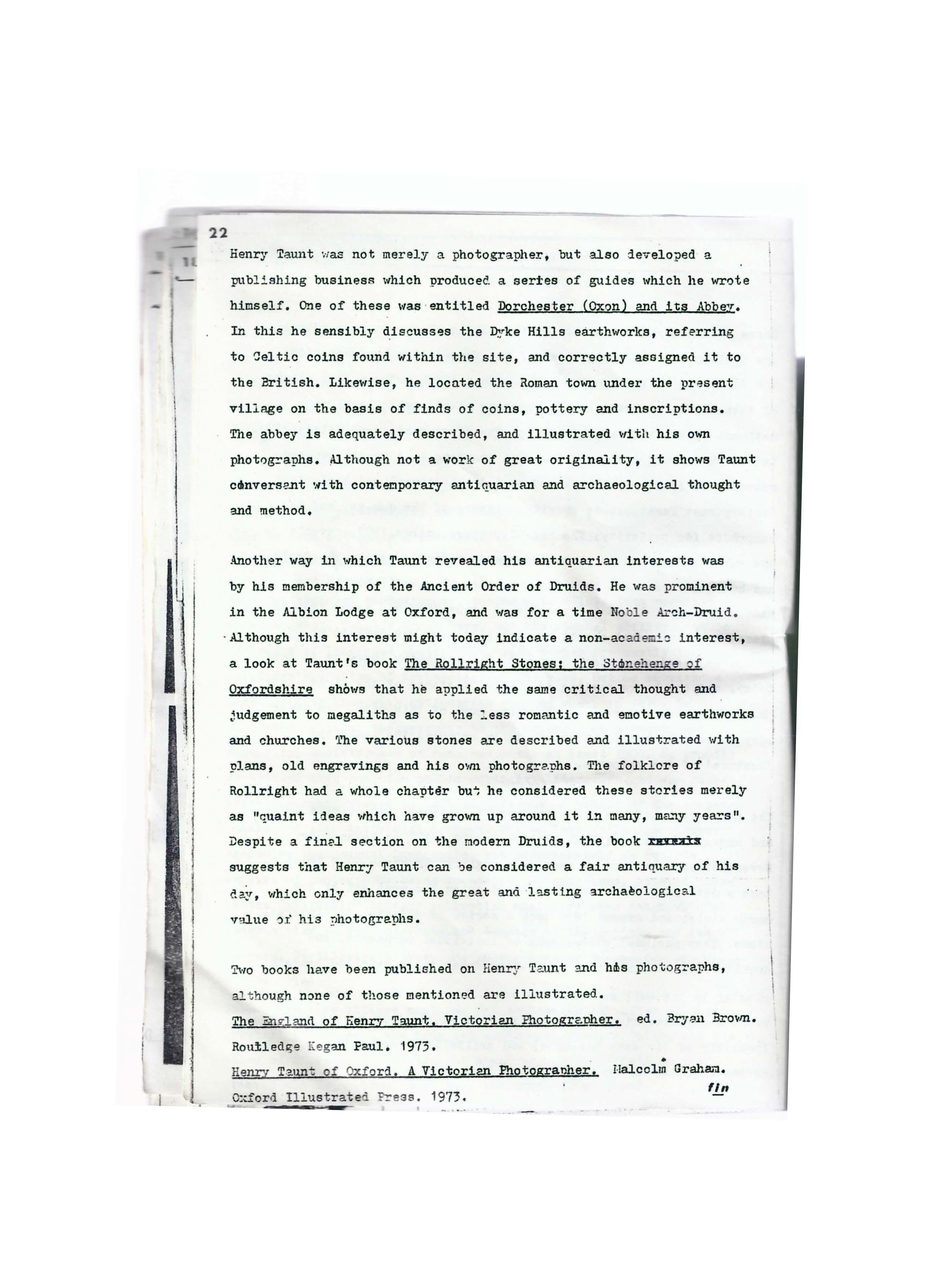
. i-lalcolm Graha.-.i. fJ..!,
22

23
over
see
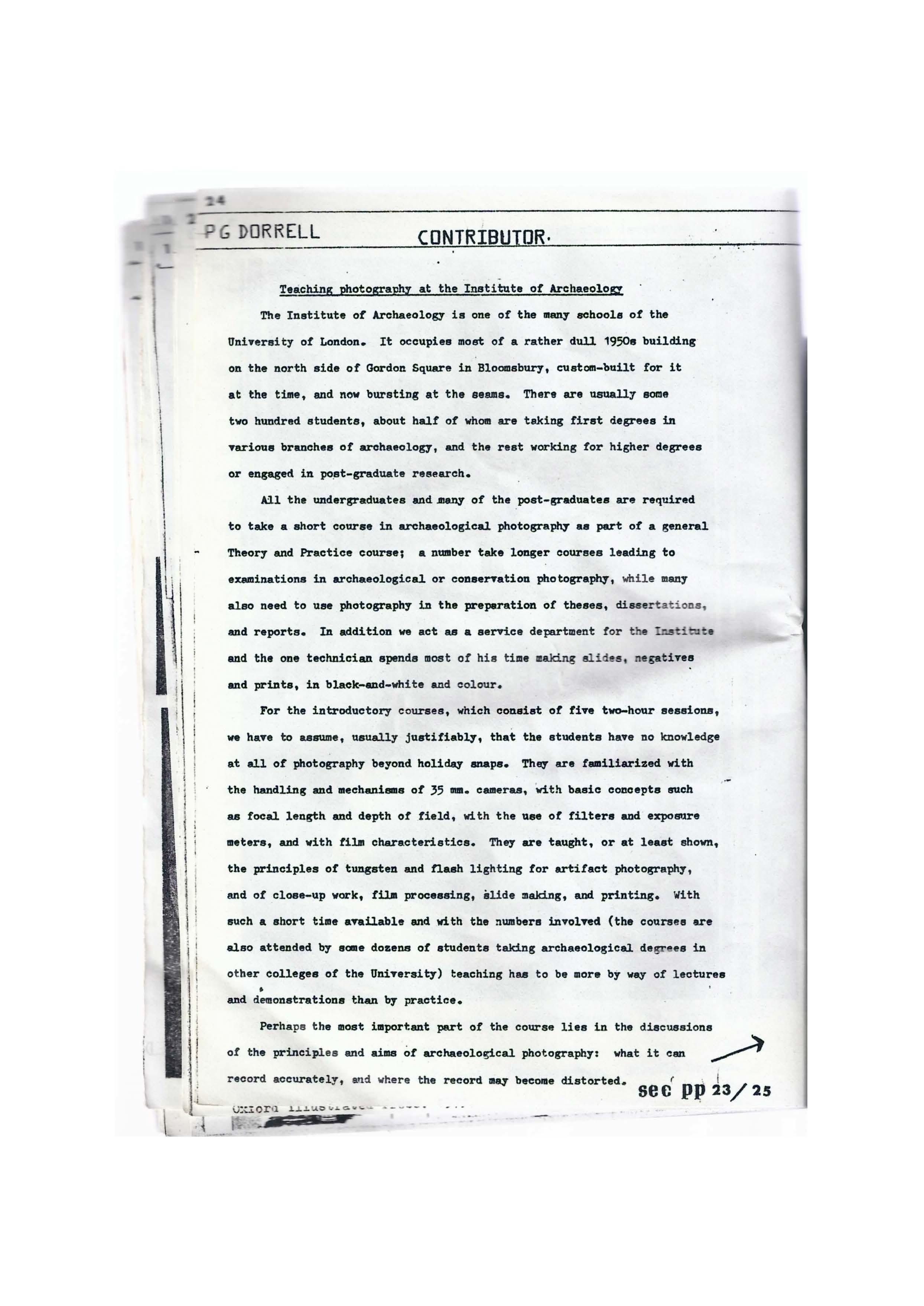
DORRELL CONTRIBUTOR·
Teaching photograph;, at the Institute ot Archaeolog;:
The Institute of Archaeology is one of the many schools of the UniYersity of London. It occupies most ot a rather dull 1950s building on the north side of Gordon Square in Bloomsbury, custom-built for it at the time, and now bursting at the seams. There are U8Uall:, some two hundred students, about half ot whomare taking first degrees in Tarioue branches of archaeology, and the rest working tor higher degrees or engaged in post-graduate research.
Ail the undergraduates and .man,- ot the poet-graduates are re'luired to take a short course in archaeological photograph,- aa part of a general Theory and Practice course; a number take longer courses leading to examinations in archaeological or coneerYatiou photograph,-, while many also need to use photography in the preparation of theses, diesertations, and reports. In addition ve act as a serYice department for the I..c.stibte and the one technician spends most of his time malci.ng slides, negatins and prints, in black-and-white and colour.
For the introductory courees, which consist of tiTe two-hour sessions, - haTe to assume, usually justifiably, that the students haTe no knowledge at all of photography beyond holiday snaps. ThECTare f•iliarized with the handling and mechaniema of 35 •• cameras, with basic concepts such as focal length and depth of field, with the use of tilters and exposure meters, and with film characteristics. They are taught, or at least shown, the principles of tungsten and fiaeh lighting tor artifact photography, and ot close-up work, film processing, iilide :naldng, and printing. With such a abort time aTailable and with the numbers inYolTed (the courses are also attended by acne dozens ot students ta.king archaeological degrees in other colleges of the UniTersit,-) teaching has to be more by we:, of lectures . and demonstrations than by practice.
Perhaps the most import.ant pert of the course lies in the discussions of the principles and aims of archaeolo~cal photography: what it can / record accurately, and where the record ma,- become distorted. r I sec pp23/ 2s u:uora .1..J..i.u.o..,.,_G_,'-.._

In g!'lneral
three aims are reiterated: the recording of a mllXi!llUII! g c o: in: :- tion, •,ohether of a site or of an artifact; the avoidance of dietor i n ,:;f size relationships, tones or colours; a.~d the standP.riization of that photographs of structures and objects may be compared without siai =~ties or differences being masked by the photographer's whim in the choice of lighting, viewpoints, backgrounds, or other variable~.
In the longer courses students also learn the use of larger-format cameraa (6 x 9 cm. and 5 x 4 in.) including, of course, the use of camera movements. They should become reaao'nably proficient in operating, proc1tssing ar.d printing using panchromatic emulsions, and eome instruction is given in the use of lith and IR. fil.llls and in direct and fluorescent UV. Colour printing is covered only briefly - the cost of materials prohibits very much practice.
Although this curriCulWII may sound fairly comprehensive, the deficiencies are obvious enough. Like any other technician an archaeological photographer needs a reasonable theoretical knowledge, and a familiarity with the tools of the trade. In addition he or she needs a clear idea of the requirements o! archaeological reports and publications, and experience of the probl1tms likely to be met with on excavations and in museums. Perhaps the most effective way of learning to deal with such problems is to work with an experienced photographer on a well-run dig or in an efficient museum departaent - an apprenticeship scheme in fact. Certainly such knowledge cannot be gain'!d wholly in a teaching department such as ours, particularly when the course for::is only one part of a demanding timetable. Photographing the faqades of Blo0111sbury is not an entirely adequate preparation for photographing a waterlo!ged mediaeval quay, or a palaeolithic cave-site, or Mi Inca aqueduct, or the base-levels of a Sumerian tell.
In the matter of artifact photography our students fare rather oet:er. Not only does the Institute possess extensive teaching collections, but the fact that most of the staff are working archaeologists, engaged ~n surveys and excavations all over the world, ensures a constant flow of sJ.l types of art~facts. Objects are photographed for study, for publication, and during the ~ou:-se of conservation in the Institute lsbo,o.tories.
25

anci
coins, tablets and seals, pawri, flints, and carbonised grain - the Tariety is enormous and there are few occaaions when students cannot gain practice with the aorta of artifact which the7 might encounter in their particular fields.
What we tey to do, in general, is to teach the fundamentals of photogra~, and to ghe a basic knowledge of the requirements and pitfalls of recording, and a familiarit7 with apparatus and -terials. Experience of artifact photograph7 ve can giTe in the Institute; field experience must be gained elsewhere.
P. G. Dorrell J.iT.1980
LOST STATUE
.A

1Tl-lERE IS ONLY ONE Wf.Y TO I PROVE OUR GROUP
MAGAZINE
SEND ME YOUR LETTERS. VIEWS, ARTICLE O ES Pl-lOTOGllAPl-1S ETC;
TYPEWlllTTEN TO 6inches WIDE MAX
:AN S-1\-E FOR TUE SUMMER ISSUE WILL HEL
TO KEEP TIIINGS I-IUMMING, (UK ONLY)
PHOTOS- don! be IO<)lus~y-mall- anything- all e
A LOST SfATUE0~ :<INGJAl-~S 11,
On December 2Jrd 1685 a Dutch carven called Arnold Quellln, then workln~ in London, signed an agreement with the Earl of Strathmore to provide statues of the four Stuart Kings. Jaaes 1st was to be depleted in his royal robes, Charles 1st in armour and Charles llnd and James llnd in Roman costume although in different poses. The statues were to be 7 feet high and made of lead specially hardened and painted to look like brass. Quellln was to be responsible for packing them up and loading them onto a ship in the port of London for transporting to Scotland. Completion date was to be June 1st 1686 and Quellin was to receive a total fee of £160 for his work.
The statues were duly provided although Quellln died in September 16P.6. When the poet Gray visited Glamis in 1765 he described how he passed through three gates to an inner court adorned with statues of the four Stuart kings. A century later and the position had sadly changed for the worse. An account published in 1687 describes how the statues had been taken down and were lying out of sight, sadly mutllat.ed. ?erbapSf as a result of this report two of the statues were restored and still stand in front of the castle, the other two, pcsslbly damaged beyond repair, have disappeared •
Although the statue of ,rames 11 has been lost it is possible to visualise fairly accurately what it looked like, partly because it was included in a view of the castle engraved about 1750 and partly because it was said in an eighteenth century traveller's account to be like the statue of James 11 in Whitehall.. Fortunately the London statue still survives, although 1t now stands in front of the National Gallery in Trafalgar Square. Comparison between engraving and surviving statue show that the t.wo must indeed have been very similar so we do have a very good idea of what the Scottish James was like,
The similarity is in fact so close that it raises a further question. The London James ls commonly attributed to Grinling Gibbons, but altho~h Gibbone wood carving was beyond compare his work in other materials was not in the same class. Since Quellin worked for Gibbons the possibility exists that the London James was in fa.et the work of Quellin and indeed that the two statues •ight have been caset from the same mould. Unfortunately such evidence as then•is does not confirm this; althou~n~ it is unlikely that the London statue was the work of Gibbons himself and proba~le that it was executed by others in his workship. However other craftsmen from the Low Countries were apparently involved, so althou~h Quellln may have had some hand in both the statues under discussion lt seelllS unlikely that the two were as closely related as seemed likely at first sight.
~!.R .Apted
6 April 19"12
(~
27
lBillingsgate F;lsh Market;. site of. Your Editor felt· rather pri-ri.lidged rec ently when Collllllittee MemberJohn. French - - - --·invited me to join hi• on a visit with the·_compliments of The Press Club to this very interesting site, we.were allowed to. walk the site and were given a very comprehensive idea of the use of the area from Parly Roman times.A_great deal remains (no ptm intP.nded) from the · time of the Great Fire of London, even to scorch marks on a wall reputed- to I
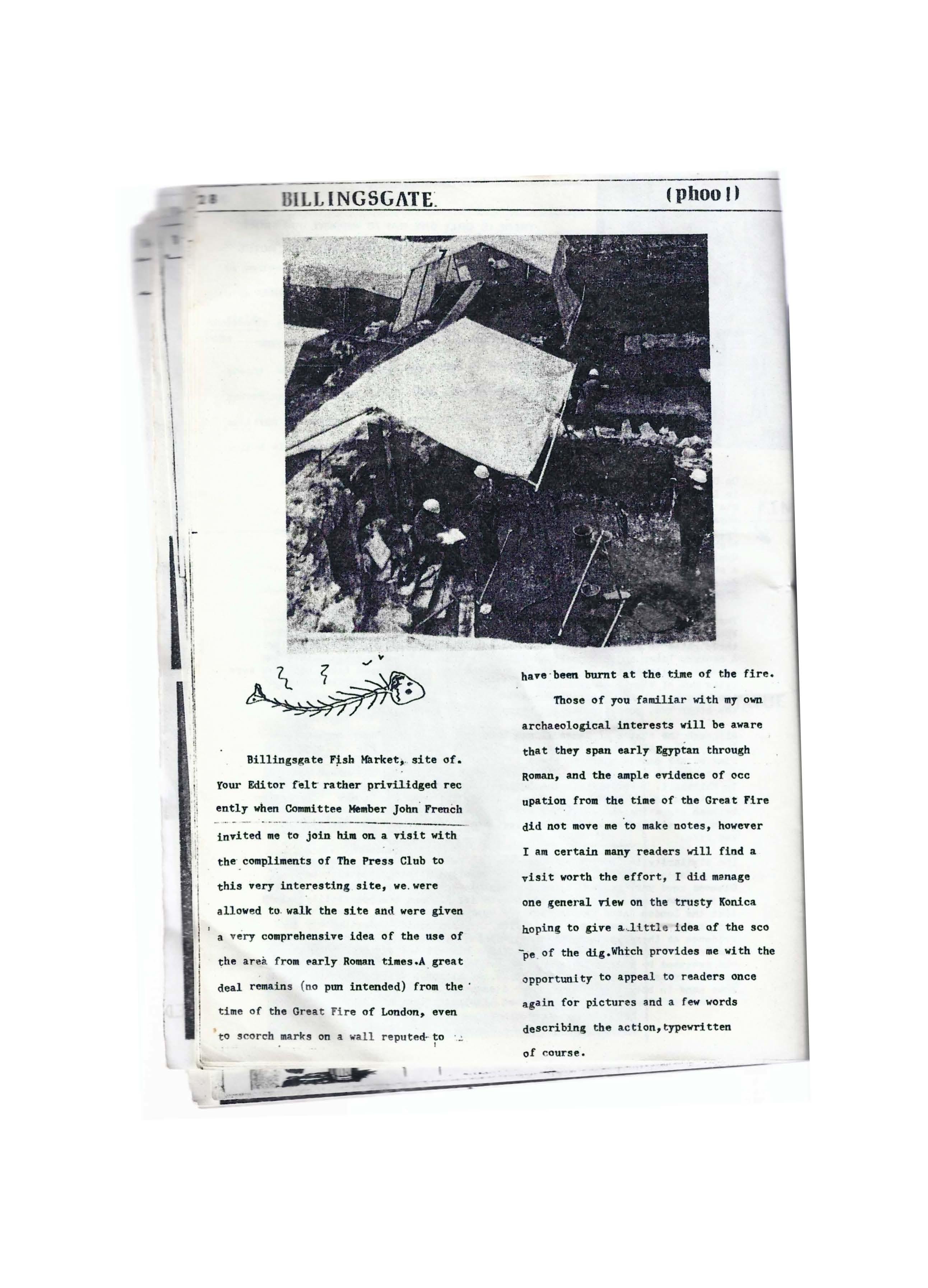
have been burnt at the tillle of the fire. Those of you familiar with my own archaeological interests will be aware that they span earl~ Egyptan through Roman, and the ample evidence of occ upation from the time of the Great Fire did not move me to make notes, however I am certain many readers will find a visit worth the effort, I did manage one general view on the trusty Konica hoping to give a.little idea of the sco -pe.of the dig.Wh±ch provides me with the opportun.i ty to appeal to readers once again for pictures and a few words describing the action,typewritten of course.
ILL INGSGATE·.
( phoo I)
NEWS
Fine example of Statue photography by Bert Craweshaw ARPS.A sample from .be portfolio by Bert to be published in the Winter/ Spring• PROOF••
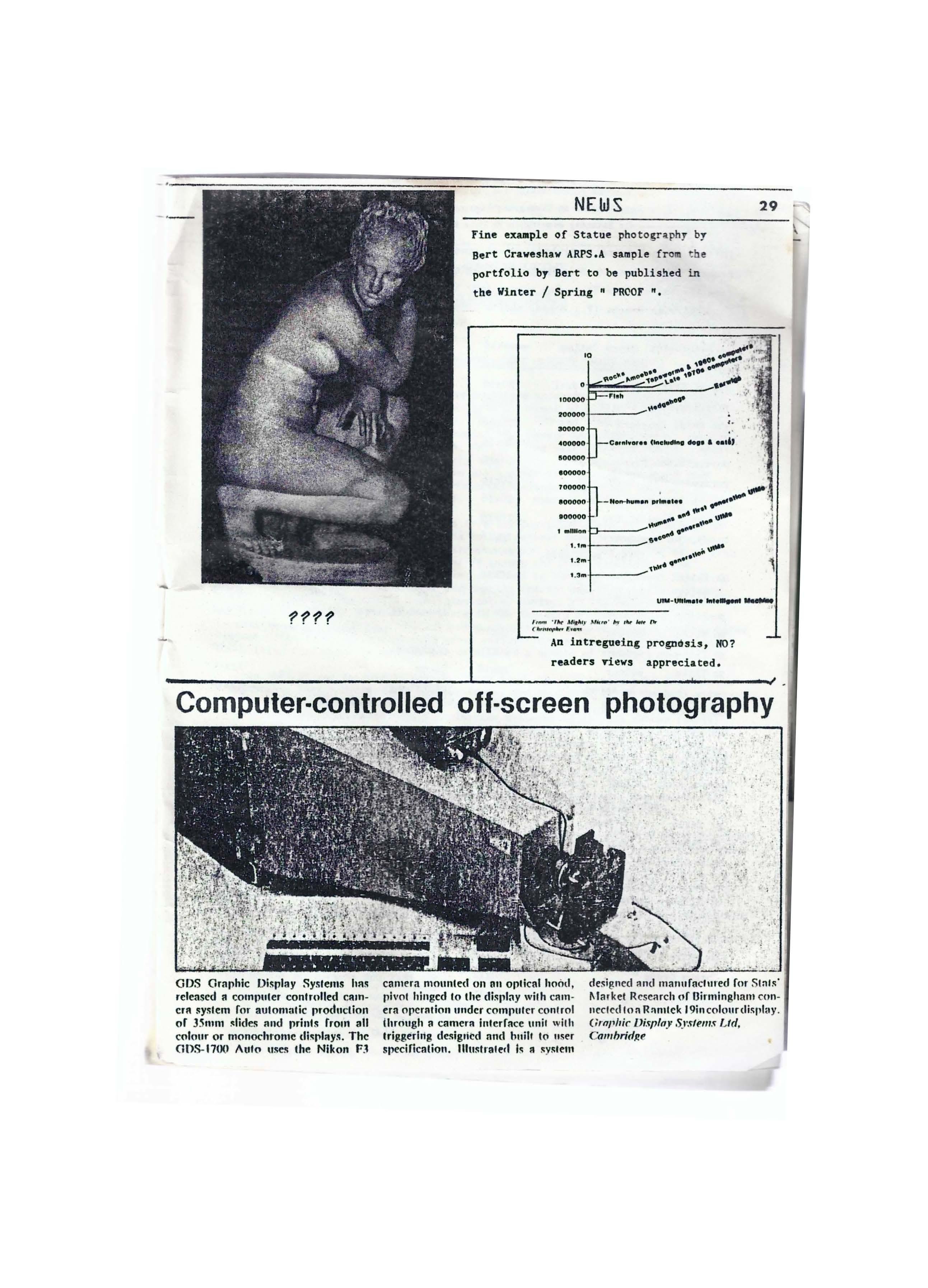
????
UtM-Ult--•• ""'
An intregueing prognesis, NO? readers news appreciated.
Computer-controlled off-screen photography
£,ti1~1j;{
GDS Graphic Display Sy~rems Im~ released a computer conlmlled c11mcr11sy~lem for autonmlic proclnclion or 35mm ~tides 1111d print~ from all colonr or monochrome displ:iy~. The (lt)S-171XI /\ulo u~es the Nikon F.1
ca111eramonnted on 1111opricnl hooil, pivot hinged t.o the disrlay wilh c:imern orcrnrion under comrurcr conrrol through a camern interface unil wilh lriggerhlg de~ig1itd and hnilt to nst'r speciflcnlion. lllustrare,1 I~ 11 system
designed :incl mannfactnred for S1:i1s· I\ larkel Rcsemch of Oirmingha111conneclcd lo :i R :imlck I9in colo11rdisf)l:1y. UrnJ'hic Vi.tpfny SysfPm.t Ltd, Camhridl!('
10 ........... 200000 1----~ 100000 300000 400000 500000 ,00000 700000 100000 1.3m+------29
''""" -,~ Afi11t,,·~,.,,,. Or Cltrn"""'" F...-.1"
;l;:~,It.t , • ..._or,,._;,,.I•,•
.: t : • .,• .,
li bers prints e1lubit "• ur •ST Hole Restaura 11t Abincdon on Thamu,h.i~.ip, •d y Suppor booked for ----=====---- the Saturday ,...,oiog,in le Rut.auruit Abi.ncdon.
Photographs submitted by Archaeological group e ers and displayed at Members Exhibi.tion, Mr Hole Re taur"nt, Abingdon on Thames.Tor 5 veeks from the end of Jw1e 82 to 8th Augui: last at no co~t to the group., •• Chairmans PaneL. (V.J.Heppelthvaite ARPS} E,Butcher esq:
Title
Archaeological Group Outing
Autumn sea of Steps,Wells Cathedral rnterior,Hever Church
The Ford, Eynsford portrait,Chinese girl portrait,Bcn Homme portrait, Your Move church interior, GolJen Lectern church interior, Les Adeles Study, Just geometry
Arthur Page ARPS, No
Title colour
NO
Title colour
No
Title colour
No
Title colour
NOTitle colour
~o
No
Title colour
Dr Apted
title subject Egypt
NO
Title
No .Title "
NOTitle No
No
Title "
Robert Pitt ARPS
Title A Tomb
NOTitle Donkey
NO
No
Title Sarcopha~s
Brian Tremain
Title Chatham Dockyard
Ne
Title "
NO Title "
NO
Title
MuseumGroup Nelson -48x16- ·
·20:x16

Christchurch Fent
Statue oolmen Beaker Brooch
jJohn E,Pullinger esq: colour colour colour
Miss Mary !-litchel St Helens prehistoric house panel l;!ynagog
Victor Twine esq: Windovs Colour Pulpit colour
Leaded Wfndows colour
Cloisters
Steps Cloisters
John Brown esq:MJST. --
Just 10 exhibitors who filled all avai lable \fall space at the Mr Mole Restau rant Abingdon-on~Thames recently, Being less tb,ui 10% of the Group memb ership,not a very laudable effort group, However,top marks for the above for the very good auality photographs sub mitted and for the effort. An excel.lent dinner aws enjoyed by all who attended the Saturday at Abingdon and •,1e are certain to repeat the experiment.
The Chainnan would like to thank those that put themselves out on this occasion, the Societys thanks must also go out to the Hr Mole Restaurant for donating their premises and for the most excellent JiMer • Chnirman ••• ,,
___________
20x!6 20x16
20x16 20xJ6 20x16 20:x16 20x16 20xt6 2ox16 20x16 20x16 20:x16 20x16 20x16 20x16 t6xt2 16x12 t6x12 16x12 16x12 16x16 20x16 20x16 16x12 16x12 !6x12 16x12 16x!2 16x12
10x8 !Ox8 10x8 !Ox8 10x8 !Ox8 10x8 !Ox8 10x8 10x8 10x12 10:<12 10x12 12x10 12xl0 12x!O

The ROYAL ENGINEERS DIVING ESTABLISHMENT
ROYAL~GUG:.RS' !>IVERS M!D '!'!IE TUDOR':!ARSHIP "MARYRO.<;E"
The first serviceman. to dive using breathing apparatus was Colonel Pasleya pioneering Commandant of the Royal Engineers' School of Military Engineering and i:wentor of the electric detooa.tor. Between 1839 and 18115 Pasley' s divers successfully blew up wrecks that obstructed the passage into Portsmouth. As they completed the destruction of the ''Royal George" they were asked to r9move ti111bers ··projectin,: from the seabed at the nearby site of the "Hary Rose". '#hen the:, departed th~ only trace of her location was a cross on a war office chart thst would later be discover!!d in 1966 by historian Alexander McKee and lead him to anke sonar surveys in the correct area.
In 1969 at McKee's request divers from the Royal Engineers Diving School at Marchwood used water jets and air lifts to dig several deep trenches across the site. That :,ear they revealed 'timber structur.es 'lnd located the remains of an iron gun, and in following :,ears they recovered cannon and other artefacts. The decision to recover the "Hary Rose" was confirmed in 1980 and the Royal Engineers were asked for advice on underwater-engineering and for assistance with suitably qualified divers. The Army's Superintendent of Diving, Lt Col Peter Chitty mobilised the support of senior officers in the Ministry of Defence and proposed an outline recovery scheme. The Inspector of Diving, Capt Jon Brannam was appointed Project Officer and advisor on underwater engineering, to work with R J Crocker (Consultin~ Engineers) to develop the details of a number of recover:, options.
In 1981 it was decided to recover "Mary Rose" by positioning over the site on 4 adjustable legs a rectangular lifting frame, and attaching it to the .hull with bracing ties connected to bolts drilled through up to 30" of timber; next a prefabricated cradle, lined ••ith a conformin~ mattress of special rubber fabric bags, would be placed nearby on the se:tbed and "Mary Rose" tr11nsferred unden1ater into it before being lifted to the ourface in her protectiTe 'locked box'. The plan received approval from the Defence Ministry Secretary of State as an official military training project such that many months work by up to 35 Engineer divers at a'time - worth over £300,000 - could be supplied at only a nominal charge, thus achievin~ two goals in one : valuable experience for Army divers, and suostantial Government aid to an historic pro,ject without having to give actual cash.
Theengineering phase of the recovery operation began in 1982 and Royal Engineers have been heavily involved throughout : the diving barge "Sleipner" was refitted at · Marc~wood, the Underwllter Lifting Frame•was l'lunched at Hythe and fitted out at Marchwood before being towed to site and positioned over the wreck, the cradle has been built at Marchwood on its ~ransport barge, and so~e 60 Sapper divers have dug over 300 tons of silt from around the hull during more than 2000 hours underwater as they ;,rep11re to tunnel ds;ht underneath "M:ar:, Rose" to m'lke her ready for recovery.
In the last stages of the oper!ltion the Royal En~neers will place "Mary Rose'' into her cradle and inflate the mattress bags to support the 370 tons of timber as ahe is lifted through the water surface.
Further details 11111:,be obtained from:
the Royal Engineers Diving Establishment l-111rch•.•:oodfiilitar:, Port Southampton S04 4;.a 03) 861i8?.1 Ext 245 or 322 0 0 0 0 0
------------------------~ NEWS
.
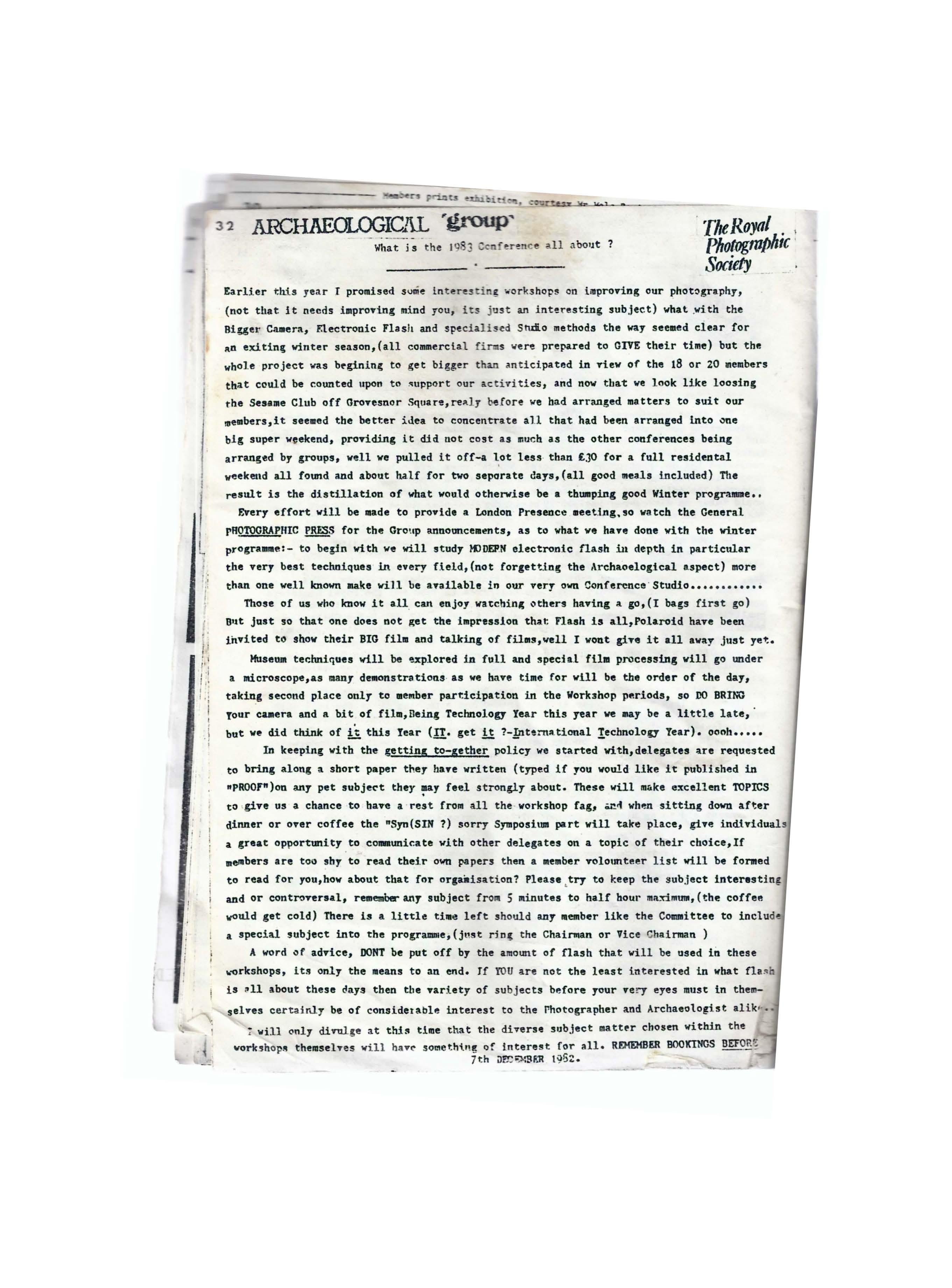
What is the JQ J Cc ennce all abo1Jt ?
Earlier this year I promised svme interes ing .orkshop9 on improrlng our phot~graphy, (not that it needs improTi.ng 111indyou, its just an int~'!"esting subject) what .with the Bigger Camera, F.1.ectronic Flash and specialised Stui.o methods the way clear for AD exiting winter season,(all com11erclal firms were prepared to GIVEtheir time) but the whole project was b~ginin~ to get bigger than anticipated in Tiew of the 18 or 20 that cl!uld be counted upon to ~upport our activities, and now that we look like loosing the Sesaae Club off OroTesnor Squan, re;,.ly before we bad arranged 1118tters to suit our the better iJea to concentrate all that had been arranged into ~ne big super weekend, prorlding it did not cost as much as the other conferences being arranged by groups, well we pulled it off-a l,ot less- than £JO for a full residental weekend all found and about half for two separate days, (all good 111ealsincluded) n1e result is the distillation of what would otherwise be a thumping good Winter prografflllle,,
P:Tery effort will be to proTide a London Presence aeetlng.so watch the General rRQ!Q2M!HIC PRESSfor the Gro!rp as to what we han done with the winter progra-e:- to begin with we will study ll)OEP.l'f electronic flash in depth in particular the very best techniques 1n eTery field,(not forget~lng the Archaoelogical aspect) more than one well known will be aTailable in our very own Confercnce·studio, •••••••••••
11iose of us who know it all. can enjoy watchin~ others having a go,(I bags first go) 8•1t just so that one does not ,;et the i111presslon that Flash is all,Polaroid haTe been inTited to show their BIO film and talking of fil111s,well I wont giTe it all away just ye1:, lfuseU111techniques will be ~xplored in full and special processing will go under a lldcroscope,as manr de110nstrations• as we have ti111efor will be the order of the day, takin~ second place only to participation in the Work3hop periods, so DOBRING your cuera and a bit of Technology Year this year we ,nay be a little late, but we did think of it this Iear (IT, get ll ?-!nterna.tional Iechnology Year). ooc,h.,
In keeping with the getting to-getber policy we started vith,delegates are requested to bring along a short paper they haTe written (typed if you would like it published in npROOf")on any pet subject they '!'8Yfeel strongly about. These will make excellent 1UPICS to giTe us a chance to have a rest from all the workshop fag, when sitting down after dinner or oTer coffee the "Syn(SIN ?) sorry S)'lllposilllllpart will take place, giTe indlTiduals a great opportunity to co-unicate vith other delegates on a topic of their choice,If are too shy to read their own papers then a 111emberTOlounteer list will be formed to read for you,how about that for orgailisation? Please,try to keep the subject interestin~ and or contr.>Tersd, rememberany subject fro1115 l!l.inutes to half hour 11tl\:d11111111, ( the coffee w0uld get cold) There is a little ti•e left should any 111einberlike the Committee to include a special subject into the programnie,(just ring the Chaiman or Vice Chainaan)
A word of adTice, DONTbe put off by the amount of flash that will be used in these ~-orkshops, its only the means to an end, rr YOUare not the least interested in what na~ is •11 about these ~ays then the Tariety of subjects before your Ter-y eyes must in tbemselTes certainly be of considerable interest to the rhotographer and Archaeolo~ist alik~ •• ; vill ~nly diTUlge at this time that the diTerse subject matt~r chosen within the vorksbopll theiasehes will haYc sol!lethi.n« of interest for all, RD<EMBERBOOICTIIGSDEFO~~ 7th ill':C~:SF.'R 196;:,
I
I I I I L I. 32 ARCHAEOLOGICAL
I
",!rouf>"'
TheRo~!,..\ Pltotogmp,,te · Soc~tty
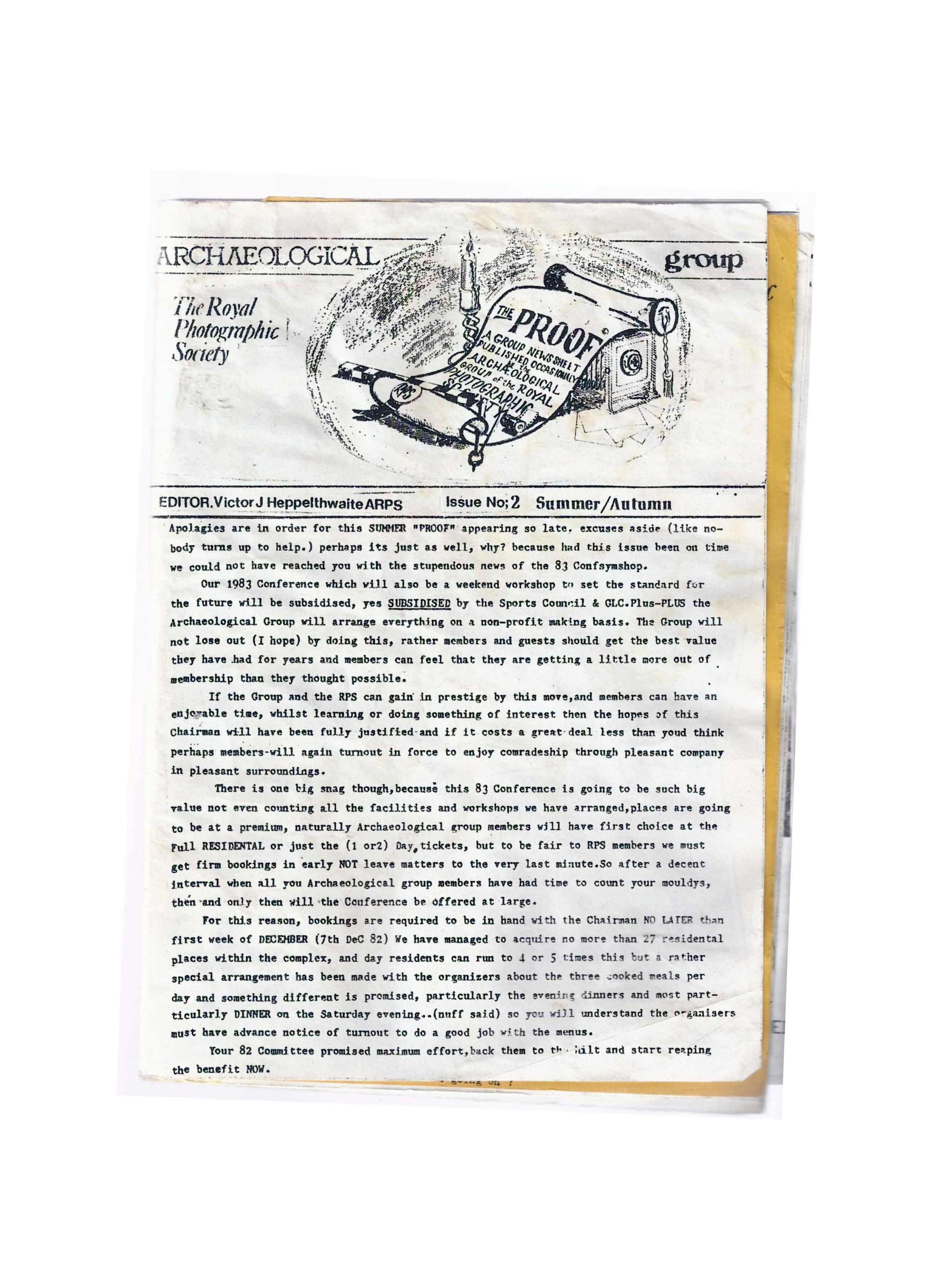




 by YOIIT CHAIRMAN
by YOIIT CHAIRMAN




























